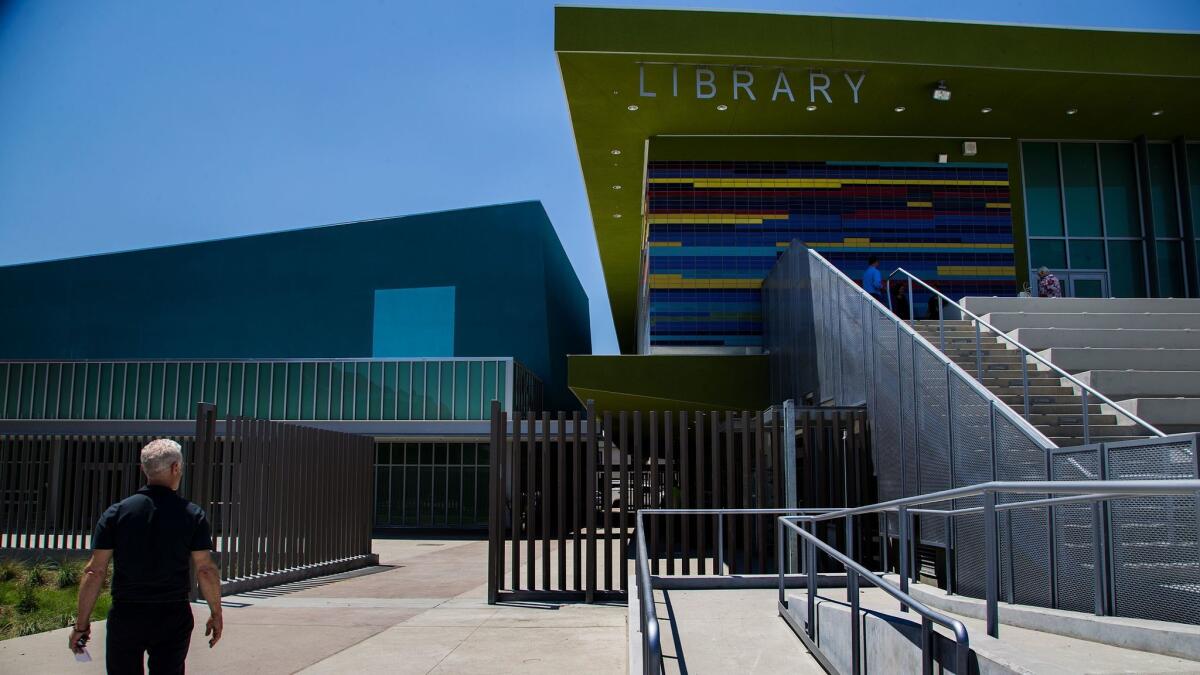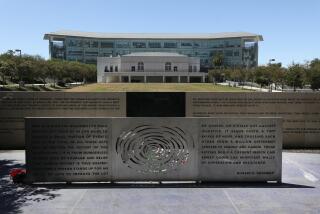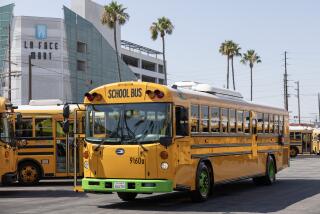LAUSD’s costly 20-year construction project ends with opening of $160-million Maywood campus

- Share via
There was a time when Los Angeles schools were overcrowded to the bursting point and officials seemed utterly incapable of building a single school.
The nation’s second-largest school system was forced to operate many campuses year-round, which made it hard to maintain order and cleanliness, cut 17 days off the academic year and deprived some students of access to honors classes and electives.
But after several costly stumbles, the L.A. Unified School District turned things around as it built 131 modern campuses.
The opening of the $160-million Maywood Center for Enriched Studies in southeast Los Angeles County, as a new school year began Tuesday, marks the end of the line for the country’s largest new school construction project, which cost $10 billion and took 20 years. The arrival of the new campus also means that Bell High School, the final district campus operating year-round, at last has returned to a traditional schedule.
Today’s school system is strikingly different than when construction began. In 2000, 77,000 students attended classes on calendars staggered throughout the year and 12,000 were involuntary bused because there was no room for them at their local schools.
Every student now is able to attend a neighborhood school, and schools are no longer overcrowded. Enrollment is shrinking rather than expanding — and even some of the new campuses are having trouble filling their classrooms. Meanwhile, $5 billion left over in construction funding is not nearly enough to renovate older campuses, and the district could be hard pressed to maintain its new schools.
Still, this week’s school opening was seen as a major achievement by district officials who have been through a lot.
“This is not just the celebration of a completed school but of a completed program,” said chief facilities executive Mark Hovatter. “We made a commitment that every student has a right to attend a local school without having to attend a year-round program.”
This is not just the celebration of a completed school but of a completed program.
— Chief Facilities Executive Mark Hovatter
The formula works for 10th-grader Angela Diaz, who transferred from the well-regarded Bravo Medical Magnet High School in Boyle Heights because the Maywood campus is just a 10-minute drive from her home in Cudahy. She no longer has to catch a 6:30 a.m. bus, and it’s easier to make track practices and other extracurricular activities.
In the 1970s and 1980s, as schools in low-income and immigrant neighborhoods filled up past capacity, the school system was unable to get two-thirds of voters to support a school bond.
A district team, in a desperate gambit, tried to raise revenue for school construction through a plan to combine a campus and retail development on the site of the historic Ambassador Hotel. That project stalled in litigation with Donald Trump, who wanted the land to be the site of the world’s tallest building. The district tried again just west of downtown with the Belmont Learning Complex, which was abandoned and half-finished over fears about hazards from the underground oil field.
The districtwide construction push began in 1997 with the passage of Proposition BB. It overcame opposition by promising specific projects at every district school. But these pledges were never attached to a budget, and it quickly became apparent that many would never happen.
The district also tried to build schools on toxic sites — to avoid the turmoil of taking homes, but then found itself stuck with costly cleanups and potentially hazardous schools.
In 2000, new Supt. Roy Romer vowed to eliminate overcrowding through a series of bond issues. He also took a potentially devastating risk. Instead of specifying that a bond issue would pay for a set of projects from beginning to end, he used the early funding to begin construction districtwide. If the later bonds had failed to pass, he would have been left with little more than 100 holes in the ground. It helped that the threshold to pass a bond had been lowered to 55%.
The dormant facilities division had to be built from the ground up, so Romer brought in a team of construction managers from the Navy.
The school board also agreed to give the facilities division independence. Schools and modernization projects would go where they were needed — and not be split evenly among the seven board members’ districts.
Eventually, L.A. Unified even resurrected the Belmont and Ambassador projects, because the classrooms were needed, even though their combined cost of nearly $1 billion attracted nationwide notoriety. So did the plan to use the bond money to provide iPads to every student, teacher and administrator — which was eventually canceled.
For a while, it looked as though the construction money could run out before the job was finished, but declining enrollment relieved the pressure.
Reduced immigration, lower birth rates and gentrification are partly responsible. So are charter schools, which are ever growing in number, propelled by philanthropic dollars and critics of traditional public schools.
Lessons learned
L.A. Unified officials and contractors have learned a lot about building schools, in ways that are evident on the Maywood campus.
For one, they became wary of building on toxic sites, and they decided to abandon the original industrial location they’d selected. Instead, they moved to evict residents and small businesses from an alternative 9-acre site. The city of Maywood unsuccessfully sued to stop the evictions. Ultimately, the various setbacks pushed the project back five years.
Like other new schools, this finished campus is supposed to double as a community center. The central classroom building can be secured while other portions remain accessible to the public. A health clinic opens directly to the outside. So do the auditorium, sports fields and a library that students can use until 7 p.m.
The library exemplifies thoughtful design. The stacks in the middle of the room don’t rise more than chest high, allowing for easier supervision by a limited staff. The front wall is glass, with an electric sunshade that can lower as needed. There’s also a skylight, although the room can be made completely dark for films or slide presentations. Couches and chairs have built-in power outlets and USB ports for cellphones. (There were no smartphones when the construction project began.)
To encourage students to gather, much of the furniture — in different heights and styles — can be moved around easily. One of the library entrances opens onto a small amphitheater. In addition to the main cafeteria, students can congregate in three smaller dining areas.
To provide security without the look of a penitentiary, the buildings themselves form much of the perimeter and the remaining fencing looks more artful than foreboding. Fracture-resistant glass replaces burglar bars.
The district also learned lessons about economy and efficiency. The floors, for example, are a concrete composite with a shiny finish, easier and less expensive to maintain than tile.
The exterior design and roof drainage channel rainwater into drought-tolerant landscaping, where pollutants can filter out before water enters public storm drains.
Another lesson the district learned is that it could take a beating for taxpayer-funded campuses that critics called extravagant, such as the Robert F. Kennedy complex on the site of the old Ambassador Hotel, where Kennedy was assassinated. That design recreated features of the hotel in the new school.
Most of the new district schools are state of the art inside, with colorful but architecturally unremarkable exteriors.
“With public schools you’re trying to get the most you can for the dollar,” said Ben Levin, principal and senior architect for DLR Group, which designed the Maywood school in hues that change from one building to another.
“People are blown away by the color and it’s such a simple thing,” Levin said. “Color is something that’s free.”
Homeowners will be paying off bonds for the school construction well beyond 2040. Right now, it costs them $131 for each $100,000 of assessed property value.
In another era, Maywood might have been packed, but it had more seats than needed to return Bell High to a traditional calendar. So the district made the new campus a regional magnet school, open to students from across the city, in the mold of the popular Los Angeles Center for Enriched Students in Mid-City. Like LACES, the new “MaCES” serves students in grades six through 12.
The concept appears to have worked. Principal Gabriel Duran says he now has a waiting list.
ALSO
UC Berkeley chancellor unveils ‘Free Speech Year’ as right-wing speakers plan campus events
City Council panel rejects plan for homes next to a freeway interchange
More to Read
Sign up for Essential California
The most important California stories and recommendations in your inbox every morning.
You may occasionally receive promotional content from the Los Angeles Times.











